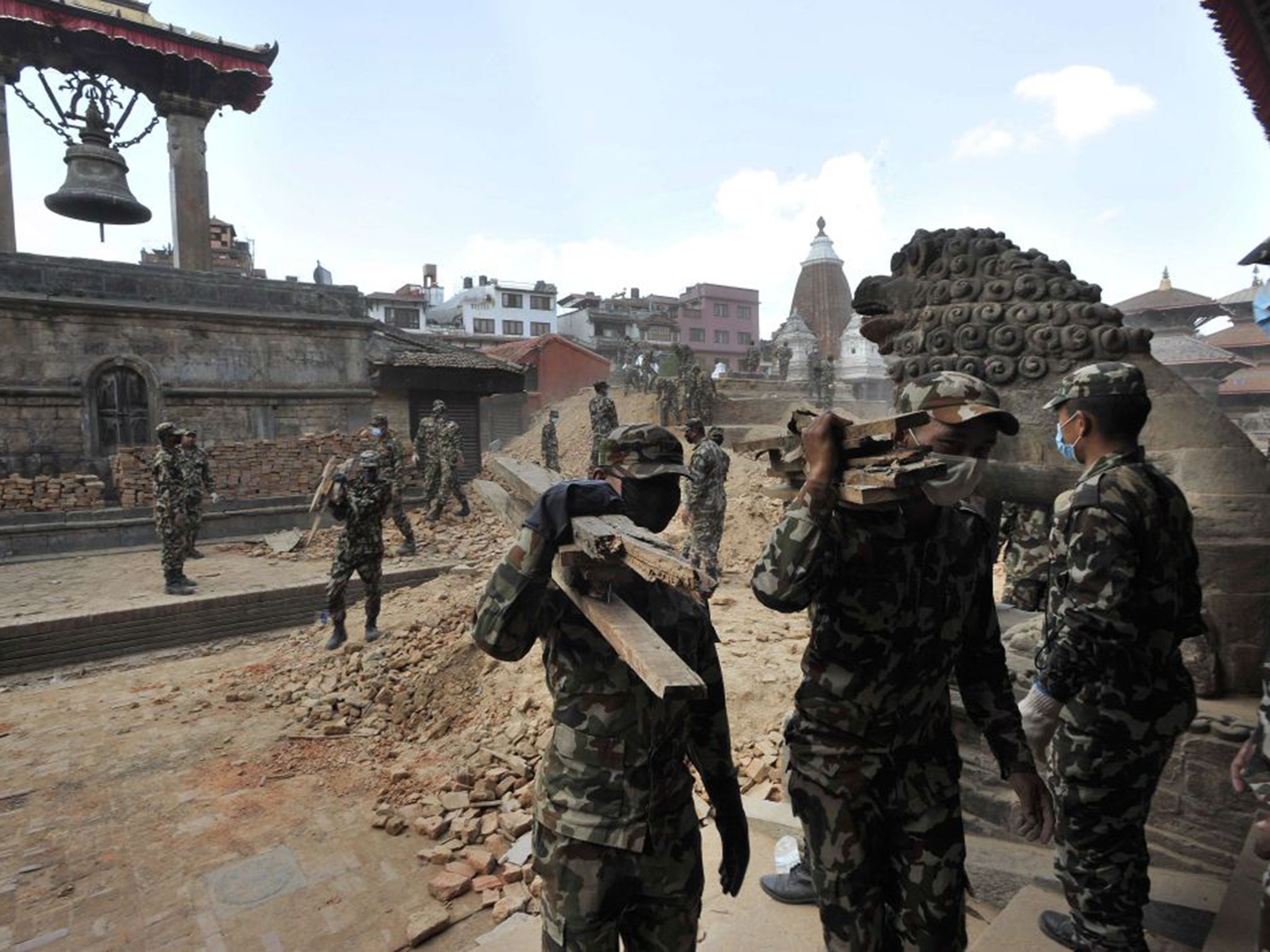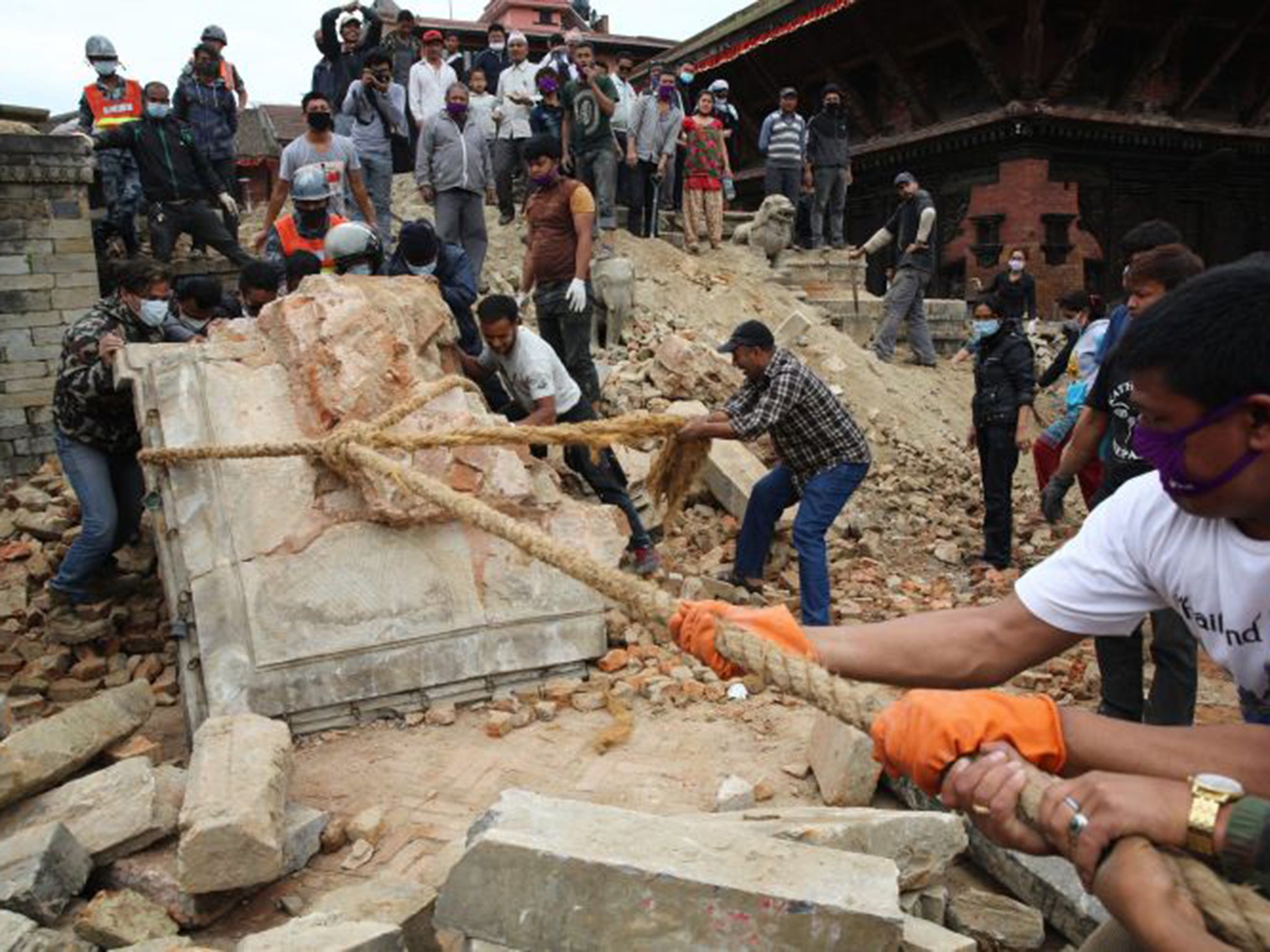Nepal earthquake: The task to conserve what survived at the Unesco World Heritage site in Kathmandu
The Independent on Sunday was given exclusive access to Durbar Square and learned of the complex task trying to conserve what was not lost

The statue of Pratap Malla was an object of veneration in Kathmandu’s Durbar Square. The King was renowned as a champion of the arts and architecture : Nepalese culture flowered, blossoming to new heights, during his reign in the 17th Century.
Now that statue lies broken amid the rubble and dust along with other prized artefacts. The palaces and temples of this spectacular complex in Kathmandu have either been destroyed or severely damaged - the dreadful legacy of the shattering earthquake of last week.
The Independent on Sunday, given exclusive access inside the Unesco World Heritage site, witnessed the sheer extent of the devastation and also learned of the complex and daunting task which lies ahead trying to conserve what has not been irreversibly lost.
The tremors had wreaked havoc across the country. Nearby in the capital, the 200 step Dharahara Tower has been razed. Other monuments of great significance have been destroyed in the towns of Patan, Bhaktapur and Bungameti; Unesco’s director-general, Irina Bokova, stated that no other natural disaster in modern times has caused so much harm to a nation’s cultural heritage.
Durbar, or royal court, Square, with origins going back to the 6th Century, described by Unesco as the “social, religious and urban focal point” is expected to be the first major project in the country in cultural restoration.
Most of the buildings have been affected. They include the Hanuman Dhoka, the old royal palace, where walls have been gouged open: Basantpur tower, where the upper floors have collapsed, the temples to Shiva and Vishnu which have fallen along with Kasthamandap, a minaret, which gave the city its’ name .
A statue of the god Garud has been toppled from its plinth. Vilas Mandir, the Temple of Luxury. with its intricately carved façade, saved in the 1970s from collapse by a Unesco backed programme, has fragmented; a magnificent 7th century statue of Narayan, 25 feet long and 15 feet wide, is surrounded by masonry which has left it punched with dents.
One building which had remained intact, however, is the Kumari Ghar, built in the mid-18th Century, where the latest Kumari, Living Goddess, was resident until the earthquake. The Goddess is traditionally chosen from pre-pubescent girls; an inscription describes the ideal attributes for the divine one: “a body like a banyan tree; thighs like a deer, eyelashes like a cow and 20 teeth.” The successful candidate also has to spend a night in a dark room with severed animal heads.

The Living Goddesses, through the ages, had premonitions of danger, according to a leaflet which was lying on the floor: “King Birendra had to give up his power and accept constitutional monarchy the year, 1990, the Kumari’s hair didn’t tie into a knot properly. In the year 2001 Kumari broke into rashes and the Royal massacre shocked the world”, it pointed out. There were no omens, however, for the calamity this year.
Volunteers have begun to start clearing the sites. Those working in the restricted inner courtyard are mainly women, civil servants or spouses of a company of billeted soldiers; the public at large are being kept out to prevent the chance of theft. There have been several attempts to steal artefacts: a guard, Ram Bahadur Kumal, said “We know one piece has gone already, so we have to be very vigilant and protect the other ones.”
The provenance of many of the items found by those clearing up was not immediately apparent. Hema Thakur came across a set of small bells from under some fallen brickwork. One of the officials from the Department of Archaeology pronounced after a quick wipe with his handkerchief: “Quite modern for this place, Prithvi Naryan Shah’s time, maybe 1770s.”
Mrs Thakur, 43, had no hesitation in coming to help. “Some people are asking why, with so many lives lost, are we wasting time on buildings”, she said. “But my view is that these places reflect the lives of Nepalese people from the past. It’s not just the kings and queens, but all the ordinary people who passed through here. We are just doing the clearing up, others, the experts, will have to put it all back together again.”

That is not going to be easy. Bishnu Raj Kaki, the former Director of the Department of Archaeology, who has been brought in to help with the restoration programme stated: “For sure we can rebuild make these buildings look the way before, maybe even more beautiful. But that will not be true conservation .
“There are many problems. As a country our preparation to save heritage at times of natural disaster has been zero. We are lacking lots of things, we lack the knowledge of craftsmanship which we need to restore them truly, this knowledge has been lost with our forefathers, so we lack, if you like, technical manpower.
“There has also been a lack of research into the composition of the material used to construct these buildings. So we need to look at everything in detail, analyse things like the make-up of the wood etc. This must be a careful process. And, of course, it will be expensive.”
There will be significant international contribution. Unicef is sending a team of experts to examine what happened in Durbar Square and other historic damaged sites. There are, however, early tensions between the future partners. “ Unicef has warned us that we must not use bulldozers inside Durbar Square, of course we are not doing that. As you saw, the only bulldozers in use are outside, clearing the streets”, Saraswati Singh, head of the office of conservation, wanted to stress.
“What we need urgently are specialist equipment and people with specialist skills. We don’t need warnings about bulldozers, we are not going to destroy our own culture; we need help to save what we can.”
Join our commenting forum
Join thought-provoking conversations, follow other Independent readers and see their replies
Comments